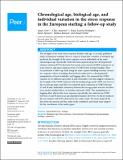Files in this item
Chronological age, biological age, and individual variation in the stress response in the European starling : a follow-up study
Item metadata
| dc.contributor.author | Gott, Annie | |
| dc.contributor.author | Andrews, Clare | |
| dc.contributor.author | Hormigos, Maria Larriva | |
| dc.contributor.author | Spencer, Karen | |
| dc.contributor.author | Bateson, Melissa | |
| dc.contributor.author | Nettle, Daniel | |
| dc.date.accessioned | 2018-11-05T16:30:06Z | |
| dc.date.available | 2018-11-05T16:30:06Z | |
| dc.date.issued | 2018-10-23 | |
| dc.identifier | 256460266 | |
| dc.identifier | 783da92b-ea07-4444-b71a-e93aaf5432ee | |
| dc.identifier | 000448082800013 | |
| dc.identifier | 30370189 | |
| dc.identifier | 85055721527 | |
| dc.identifier | 000448082800013 | |
| dc.identifier.citation | Gott , A , Andrews , C , Hormigos , M L , Spencer , K , Bateson , M & Nettle , D 2018 , ' Chronological age, biological age, and individual variation in the stress response in the European starling : a follow-up study ' , PeerJ , vol. 6 , 5842 . https://doi.org/10.7717/peerj.5842 | en |
| dc.identifier.issn | 2167-8359 | |
| dc.identifier.other | ORCID: /0000-0002-2851-9379/work/78204996 | |
| dc.identifier.uri | https://hdl.handle.net/10023/16402 | |
| dc.description | This research was funded by the Biotechnology and Biological Sciences Research Council (BBSRC) under grants BB/J016446/1 and BB/J016292/1; a doctoral training studentship to Annie Gott; and a David Phillips fellowship to Karen Spencer. The project has also received funding from the European Research Council (ERC) under the European Union’s Horizon 2020 research and innovation programme (grant agreement no. AdG 666669 (COMSTAR)). | en |
| dc.description.abstract | The strength of the avian stress response declines with age. A recently published study of European starlings (Sturnus vulgaris) found that a marker of biological age predicted the strength of the stress response even in individuals of the same chronological age. Specifically, birds that had experienced greater developmental telomere attrition (DTA) showed a lower peak corticosterone (CORT) response to an acute stressor, and more rapid recovery of CORT levels towards baseline. Here, we performed a follow-up study using the same capture-handling-restraint stressor in a separate cohort of starlings that had been subjected to a developmental manipulation of food availability and begging effort. We measured the CORT response at two different age points (4 and 18 months). Our data suggest a decline in the strength of the CORT response with chronological age: peak CORT was lower at the second age point, and there was relatively more reduction in CORT between 15 and 30 min. Individual consistency between the two age points was low, but there were modest familial effects on baseline and peak CORT. The manipulation of begging effort affected the stress response (specifically, the reduction in CORT between 15 and 30 min) in an age-dependent manner. However, we did not replicate the associations with DTA observed in the earlier study. We meta-analysed the data from the present and the earlier study combined, and found some support for the conclusions of the earlier paper. | |
| dc.format.extent | 19 | |
| dc.format.extent | 1984654 | |
| dc.language.iso | eng | |
| dc.relation.ispartof | PeerJ | en |
| dc.subject | Biological age | en |
| dc.subject | Stress response | en |
| dc.subject | Corticosterone | en |
| dc.subject | Developmental programming | en |
| dc.subject | Starlings | en |
| dc.subject | Telomeres | en |
| dc.subject | QH301 Biology | en |
| dc.subject | DAS | en |
| dc.subject.lcc | QH301 | en |
| dc.title | Chronological age, biological age, and individual variation in the stress response in the European starling : a follow-up study | en |
| dc.type | Journal article | en |
| dc.contributor.sponsor | BBSRC | en |
| dc.contributor.institution | University of St Andrews. School of Psychology and Neuroscience | en |
| dc.identifier.doi | 10.7717/peerj.5842 | |
| dc.description.status | Peer reviewed | en |
| dc.identifier.grantnumber | BB/J016292/1 | en |
This item appears in the following Collection(s)
Items in the St Andrews Research Repository are protected by copyright, with all rights reserved, unless otherwise indicated.

